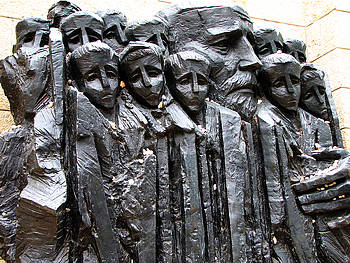 and reach thousands of daily visitors
and reach thousands of daily visitors15 MARCH 2010
NO 1554
Janusz Korczak
The greatest worker with problem children in this century, in my opinion, was Janusz Korczak of Poland. Trained as a paediatric physician, he also shifted from medicine, and in 1901 wrote a book Children of the Streets describing what could be done with street children, something which remains today a big problem in your country and mine. In 1911 Korczak established The House of Children for 200 Jewish street children. He once took one of his young children in front of a large audience, placed him before a fluoroscope (an x-ray machine) and said "Tonight we are going to look at the heart of a child. Here are the ribs, you can see him breathing hard (the kid was, of course, scared to death) and see how his little heart is beating. Look at that heart. Next time you become angry and frustrated and feel like striking out, remember what the heart of child looks like." He was so good at his work, that the Roman Catholics also appointed him as an associate worker at catholic orphanages that was quite some ecumenism in 1921! He also had a radio programme, but the station didn't use his real name for they weren't sure that Christian people would like their children to be raised according to the principles of this Jewish doctor who gave advice on raising difficult kids. (In fact when it became known that he was Jewish, the programme was taken off the air.)
But, of course, the worst was to be when Hitler invaded Poland. What were they to do with this Jewish youth worker and his two hundred children? In the event Korczak was now so famous that the Nazis offered him a chance to get away, but "Who would leave children at a time like this?" was his brusque reply. So they took him and moved the children and staff into the Warsaw ghetto. Some years earlier Korczak had written a book called King Matt the First about a boy king who would save the world which had been so messed up by adults, and in the story the 12-year-old king leads the children in a crusade marching under a green flag. So he thought it only appropriate that when the Nazi's took them to the ghetto that they should march in under a green flag.
As time went by it became clear what was going to happen. He had told a Christian friend on the outside where he was keeping a secret diary in the hope that it would be recovered to tell the story of the children during these days — which it was and published as the Ghetto Diary.
Janusz Korczak knew then that he would have to teach his children a lesson that most of us never have to teach: he would have to teach them how to die. So he went to that great youth worker Rabindranath Tagore and found one of his writings about a dying Hindu boy, and they made a play out of that and acted out the parts.

Located in the Janusz Korczak Square,
this sculpture of the great Polish-Jewish educator Dr. Henrik
Goldschmidt (known by his pseudonym Janusz Korczak) stands in the center
of a group of children and shelters them with his body and his
outstretched, embracing arms. The figure of Korczak is considerably
bigger than the figures of the children. Only his face and hands are
visible, uniting the group with their embrace.
When the time came, he made his final entry into the Diary and hid it
behind the bricks. The children were dressed in their best, the green
flag was brought out, and they marched two miles through the streets to
the chlorinated box cars, and from there were taken to Treblinka.
Some of you will have a chance, now that the walls are going down everywhere in this world, to visit Poland. If you go to Treblinka you will see that there are no more buildings; only green grass and pine and birch trees, and a memorial consisting of a ring of rocks. On each rock is the name of a city or a country from which some Jews came, one million of them, to their end in that place.
Only one person has his individual name on one of those rocks. In the centre, on the largest rock, is the name of someone in our profession: 'Janusz Korczak and children'. His final entry in the Ghetto Diary in 1942 said "I don't know who will ever care about what I am writing here; perhaps fifty years from now, someone will care."
Then he closes his diary with the simple statement, which could be the battle cry as you go out now, fifty years later, with our good wishes, into your work with children:
"I exist, not to be served or loved, but to love and to act."
LARRY BRENDTRO
From an address given by Dr Larry Brendtro at the graduation of students from Durban's Ethelbert Training Centre in 1993.